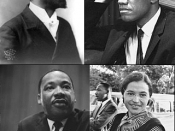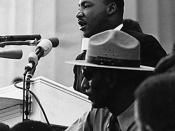Jaelin Stoudt
Mrs. Siegfried
AP Language and Composition
December 27
The Trumpet of Conscience
America, in the 1960s, was filled with bloodshed, rioting, and the clash of Civil Rights activists with the resistant white population. Sitting at the forefront of the activists was Civil Rights leader Martin Luther King Jr. MLK was "best known for being an iconic figure in the advancement of civil rights in the United States and around the world, using nonviolent methods" (Martin Luther King). King wrote The Trumpet of Conscience, a combination of "five orations" that" encompass a distinct theme pertinent to the African American civil rights struggle" (Trumpet of Conscience). MLK writes to the people of America to try to illustrate his beliefs concerning equality, war, morality, and violence. He reveals his, "most introspective reflections and his last impressions of the movement"(Trumpet of Conscience), through the use of rhetorical strategies like parallelisms, metaphors, and juxtaposition.
With the help of these techniques, King is able to portray his final thoughts on the racial and social situations in the country to his readers.
King also uses metaphors throughout his story to relate the aspects of the movement for racial equality to things that the general public could better understand. King writes:
The developed industrial nations of the world cannot remain secure islands of prosperity in a seething sea of poverty. The storm is rising against the privileged minority of the earth, from which there is no shelter in isolation and armament. The storm will not abate until a just distribution of the fruits of the earth enables man everywhere to live in dignity. (King 17)
The storm that King is talking about is the movement for complete freedom that will soon engulf
the privileged minority, the racist South. He is writing to the white supremacists...


